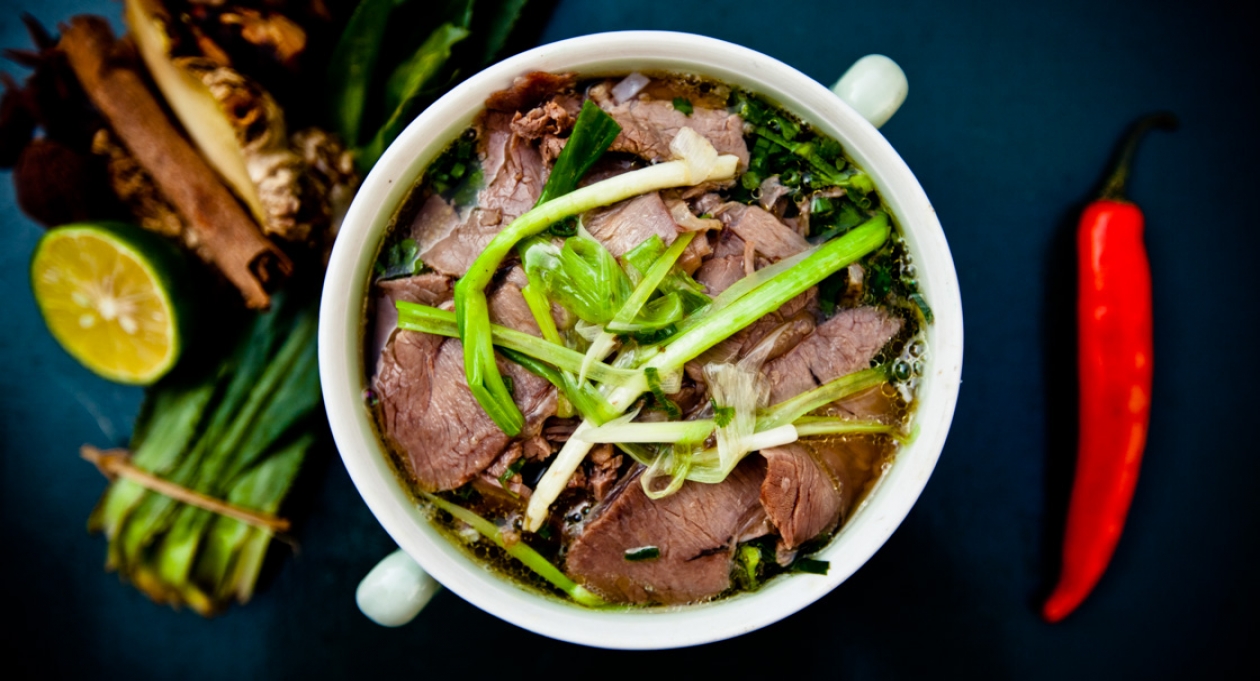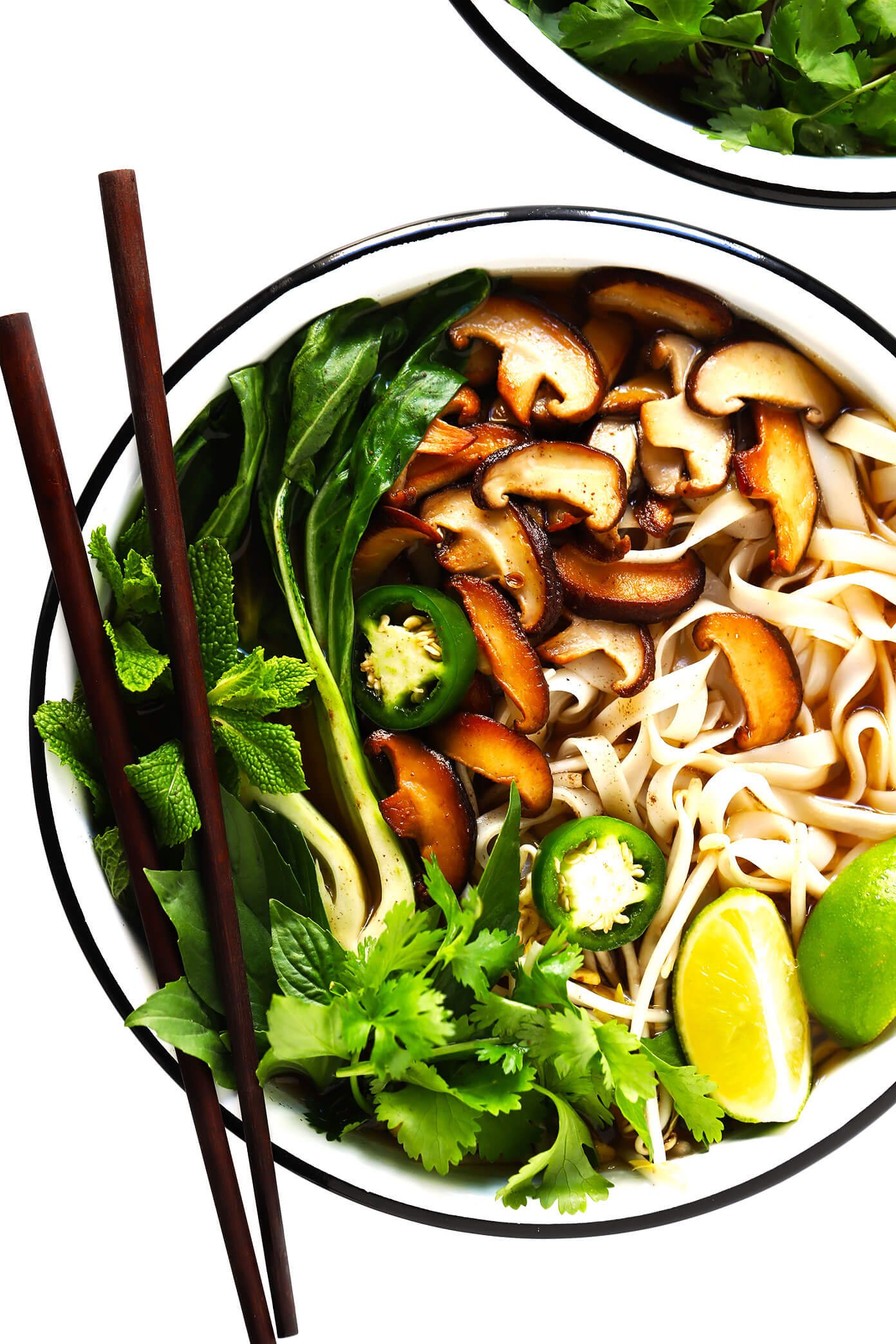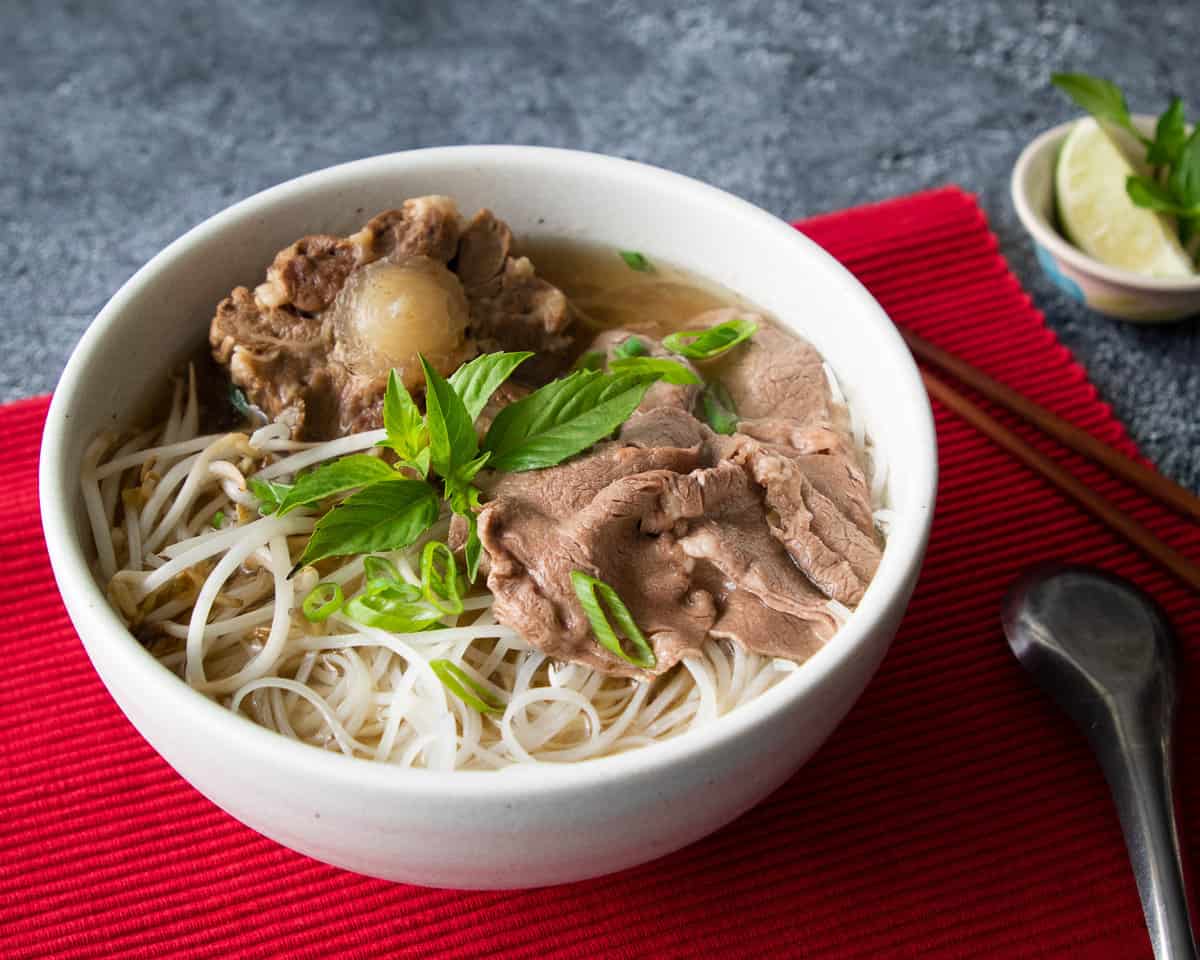For pho noodle soup and other pho noodle dishes, banh pho (flat rice noodles) are typically used. However, round bun rice vermicelli noodles are used for other dishes like rice noodle bowls and rice paper salad rolls.
Welcome to the world of Pho Rice Noodles! A staple in Vietnamese cuisine, Pho Rice Noodles are a delicious and versatile ingredient used in a variety of dishes. Whether you’re making a steaming hot bowl of pho noodle soup or creating a flavorful rice noodle bowl, Pho Rice Noodles are the perfect choice.
We’ll explore the different types of Pho Rice Noodles available and where to buy them. We’ll also discuss the health benefits of Pho Rice Noodles and provide substitutes for those who may not have access to them. So, if you’re looking to add some authentic Vietnamese flavors to your cooking repertoire, let’s dive in and discover everything there is to know about Pho Rice Noodles.

The Origins Of Pho
Pho, the popular Vietnamese dish, has gained widespread popularity around the world for its delicious flavors and unique combination of ingredients. But have you ever wondered about the origins of this iconic dish? In this blog post, we will explore the historical background and cultural significance of Pho, shedding light on its humble beginnings and how it has evolved over time.
Historical Background
The history of Pho dates back to the early 20th century in northern Vietnam. It is believed to have originated in Hanoi, the capital city, where it was initially enjoyed by the locals as a breakfast dish. Pho was commonly sold by street vendors, who would set up their stalls early in the morning to serve the busy workers and passersby.
The exact origins of Pho are still debated among historians, with some theories suggesting that it was influenced by French cuisine during the colonial era. The use of beef in Pho, for example, is said to have been introduced by the French, who also brought the concept of boiling bones to create a rich and flavorful broth.
Over time, Pho gained popularity not only among the locals but also among the soldiers who fought in the Vietnam War. The soldiers brought their love for Pho back to their home countries, spreading the dish’s popularity to various parts of the world.
Cultural Significance
Pho holds a special place in Vietnamese culture, representing a sense of community and connection. It is often enjoyed as a family meal, where loved ones gather around a steaming bowl of Pho to share stories and create lasting memories.
The preparation of Pho itself is an art form, with each ingredient carefully selected and cooked to create a harmonious balance of flavors. From the fragrant herbs and spices to the tender slices of meat and the chewy rice noodles, every element in Pho is thoughtfully chosen to create a wonderfully satisfying dish.
Furthermore, Pho has become a symbol of Vietnamese cuisine both at home and abroad. It has transcended cultural boundaries, captivating the taste buds of people from all walks of life. Today, you can find Pho restaurants in cities across the globe, serving this beloved dish to a diverse clientele.
Overall, the origins of Pho reveal a rich history and a deep cultural significance. From its humble beginnings as a humble street food to its global recognition, Pho has truly become a culinary icon.
Varieties And Ingredients
When it comes to Vietnamese cuisine, one dish that stands out is Pho rice noodles. Pho is a beloved noodle soup that is known for its flavorful broth and tender rice noodles. But did you know that there are different varieties of Pho with unique ingredients? In this article, we will explore the traditional Pho ingredients and the types of rice noodles used in this delicious dish.
Traditional Pho Ingredients
Pho is made with a combination of fresh and aromatic ingredients that give the soup its distinct flavor. The traditional Pho ingredients include coriander, anise, fish sauce, chili pepper, star anise, and onion. These ingredients are simmered for hours to create a rich and flavorful broth that serves as the base for the Pho soup.
Types Of Rice Noodles Used
When it comes to the types of rice noodles used in Pho, it’s all about finding the perfect balance between texture and taste. The most commonly used rice noodles for Pho are banh pho, which are flat rice noodles. These noodles have a smooth and slippery texture that pairs well with the savory broth. On the other hand, round bun rice vermicelli noodles are used for other Vietnamese dishes like noodle bowls and rice paper salad rolls.
To make sure you’re using the right type of rice noodles for Pho, look for banh pho in the Asian section of your grocery store. They are typically packaged as flat rice noodles and can be found in different widths to suit your preference. When cooking Pho at home, follow the instructions on the packaging to ensure that your rice noodles are cooked to perfection.
In conclusion, Pho rice noodles are a versatile and delicious staple in Vietnamese cuisine. With its array of traditional ingredients and different types of rice noodles, Pho offers a delightful dining experience for noodle lovers. So the next time you’re looking for a satisfying and comforting meal, why not give Pho a try?
Health Considerations
When it comes to enjoying a bowl of pho with rice noodles, it’s essential to consider the health implications. Understanding the nutritional value of rice noodles and how they compare to other noodle dishes can help make informed decisions about your diet.
Nutritional Value Of Rice Noodles
Rice noodles are known for being a gluten-free alternative to wheat-based noodles. They are low in fat and calories, making them an excellent choice for individuals seeking a healthier noodle option. Additionally, rice noodles are typically free from cholesterol and are easy to digest, making them suitable for individuals with dietary restrictions or sensitivities.
Health Comparison With Other Noodle Dishes
When comparing rice noodles to other types of noodles, such as wheat or egg noodles, rice noodles stand out for their lower calorie and fat content. Additionally, their gluten-free nature makes them suitable for individuals with gluten sensitivities or celiac disease. However, it’s important to note that rice noodles, like any other noodle, should be consumed in moderation as part of a balanced diet.
Cooking And Recipes
Popular Pho Recipes
Pho rice noodles are the star of the show when it comes to creating delicious and authentic Vietnamese pho dishes. With their soft and chewy texture, they perfectly complement the flavorful broth and toppings. Here are some popular pho recipes that you can try at home:
-
Chicken Pho
This recipe features tender chicken, hoisin sauce, soy sauce, Thai basil, and rice vermicelli noodles. It’s a quick and easy option for a flavorful and satisfying meal.
-
Vietnamese Beef Pho (Beef Rice Noodle Soup) Recipe
This classic beef pho recipe includes filet mignon, rice noodles, mung bean sprouts, beef marrow, and beef oxtail. It’s a rich and hearty dish that will satisfy any appetite.
-
Vietnamese “Pho” Rice Noodle Soup with Beef
Featuring beef marrow, beef chuck, bean sprouts, star anise, and wide rice sticks, this pho recipe brings together delicious flavors in a comforting bowl of soup.
Substitutes For Rice Noodles
If you’re looking to switch things up or simply don’t have rice noodles on hand, there are a few substitutes you can try:
-
Bean Thread Noodles
These transparent noodles, also known as cellophane noodles or glass noodles, are made from mung bean starch. They have a similar texture and can be a great alternative in pho or other dishes.
-
Vermicelli Noodles
While round bun rice vermicelli noodles are typically used in dishes like bun cha or rice noodle bowls, they can also work as an alternative in pho. They have a thinner texture compared to flat rice noodles.
-
Cao Lầu Noodles
Cao lầu noodles are a specialty of Hoi An, Vietnam. They are thicker and chewier than rice noodles and add a unique flavor to any dish. Consider using them as a substitute for a twist on traditional pho.
No matter which recipe or substitute you choose, pho rice noodles are sure to bring a satisfying and comforting experience to your dining table. Enjoy the flavors and textures that this beloved Vietnamese dish has to offer!
Buying Guide
For a perfect bowl of pho, selecting the right rice noodles is crucial. Look for flat banh pho noodles for the authentic pho experience, while rice vermicelli noodles are suitable for other dishes. Consider factors like thickness and texture when buying to achieve the desired taste and texture for your pho journey.
Where To Buy Rice Noodles
When it comes to finding the best place to buy rice noodles for your pho cravings, you have a few options to consider. Whether you prefer shopping in-store or online, there are various retailers that offer a wide selection of rice noodles.
Price Comparison And Popular Brands
To help you make an informed purchase, here is a breakdown of price comparison and popular brands for rice noodles.
| Brand | Price | Retailer |
|---|---|---|
| Lotus Foods Organic Traditional Rice Noodles | $4.49 | Target |
| Sincere Orient Food Rice Stick Noodles | $7.99 | Amazon.com (5% off) |
| Simply Food Premium Pho Style Noodles | $3.52 | Walmart |
| Pho’nomenal Bowl Instant Pho Noodles | $14.99 | Amazon.com |
These popular brands offer a range of rice noodles that can satisfy your pho cravings. Whether you prefer organic options or instant noodles for convenience, you can find a brand that suits your taste.
Pho rice noodles are a staple ingredient in traditional Vietnamese cuisine, known for their flat shape and delightful chewiness. When preparing your favorite pho noodle soup or other pho noodle dishes, it is important to choose the right type of rice noodles.
Round bun rice vermicelli noodles are typically used for dishes like rice noodle bowls and rice paper salad rolls (goi cuon). On the other hand, banh pho, also known as flat rice noodles, are the ideal choice for pho noodle soup.
By selecting banh pho for your pho noodle soup, you can ensure the perfect texture and taste in every spoonful. These flat rice noodles absorb the delicious flavors of the broth, creating a harmonious and satisfying dining experience.
Now that you have the knowledge to buy pho rice noodles like a pro, you can confidently embark on your culinary journey. Whether you choose to explore local supermarkets or shop online, make sure to select the best rice noodles that will elevate your pho dish to the next level.


Frequently Asked Questions For Pho Rice Noodles
What Kind Of Rice Noodles Are Used For Pho?
Pho noodle soup uses flat rice noodles called banh pho. Round bun rice vermicelli noodles are used for other dishes like rice noodle bowls and rice paper salad rolls.
Are Rice Noodles In Pho Healthy?
Rice noodles in pho don’t provide much nutritional value. To make your pho healthier, you can substitute them with brown rice noodles for more fiber. Using different types of noodles like ramen or udon is also an option if rice noodles are not available.
What Is A Substitute For Rice Noodles In Pho?
A suitable substitute for rice noodles in pho is to use any type of noodles such as ramen, udon, or angel hair pasta.
Is Pho Healthier Than Ramen?
Pho and ramen have their own nutritional benefits. However, pho is generally considered healthier due to its lighter broth and lower sodium content compared to ramen.
Conclusion
Pho Rice Noodles offer a delightful and satisfying dining experience. With their tasty flavors and versatility, it’s no wonder they are a favorite among food enthusiasts. Whether in a traditional restaurant or homemade, Pho Rice Noodles are a delightful addition to any meal, providing a wholesome and enjoyable dining experience.

